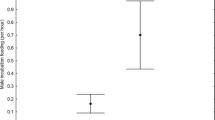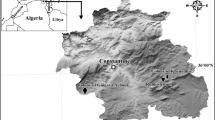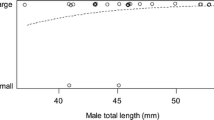Abstract
This study examines nest building and mating in relation to size in male corkwing wrasse, Symphodus melops, in the absence of male–male competition. We kept males of varying size together with mature females in tanks containing adequate materials and sites for nest construction. Our results indicate that the size of territorial males does not influence the ability to construct a nest. However, larger males initiated nest building earlier than smaller males and nest size correlated positively with male size. Furthermore, male size did not affect whether or not a nesting male succeeded in mating, indicating that male size was not essential for female acceptance (i.e. whether or not a female is willing to mate) of a male in the current situation.
Similar content being viewed by others
References cited
Anderson, M. 1994. Sexual selection. Princeton University Press, Princeton. 599 pp.
Balon, E.K. 1975. Reproductive guilds of fishes: a proposal and definition. J. Fish. Res. Board Can. 32: 821–864.
Chelappa, S., F.A. Huntingford, R.H.C Strang & R.Y. Thomson 1989. Annual variation in energy reserves in male three-spined stickleback, Gasterosteus aculeatus L. (Pisces: Gasterosteidae). J. Fish Biol. 35: 275–286.
Clutton-Brock, T.H. 1991. The evolution of parental care. Princeton University Press, Princeton. 352 pp
Côte, I.M. & W. Hunte. 1989. Male and female mate choice in the redlip blenny: why big is better. Anim. Behav. 38: 78–88.
Crawford, S.S. & E.K. Balon. 1996. Cause and effect of parental care in fishes. Advances in the Study of Behavior 25: 53–107.
Danylchuk, A.J. & M.G. Fox. 1996. Size and age-related variation in the seasonal timing of nesting activity, nest characteristics, and female choice of parental male pumpkinseed sunfish (Lepomis gibbosus). Can. J. Zool. 74: 1834–1840.
Darwall, W.R.T., M.J. Costello, R. Donnelly & S. Lysaght. 1992. Implications of life-history strategies for a new wrasse fishery. J. Fish Biol. 41(Suppl. B): 111–123.
Dipper, F.A. 1981. The strange sex lives of British wrasse. New Scientist 14 May: 444–445.
Dipper, F.A. & R.S.V. Pullin. 1979. Gonochorism and sexinversion in British Labridae (Pisces). J. Zool. (London) 187: 97–112.
Dominey W.J. 1981. Maintenance of female mimicry as a reproductive strategy in bluegill sunfish (Lepomis macrochirus). Env. Biol. Fish. 6: 59–64.
Dupuis, H.M.C. & M.H.A. Keenleyside. 1988. Reproductive success of nesting male longear sunfish (Lepomis megalotis peltastes). Behav. Ecol. Sociobiol. 23: 109–116.
FitzGerald, G.J., H. Guderley & P. Picard. 1989. Hidden reproductive costs in the three-spined stickleback (Gasterosteus aculeatus). Exp. Biol. 48: 295–300.
Galloway T.F., E. Kjørsvik & H. Kryvi. 1998. Effect of temperature on viability and axial muscle development in embryos and yolk sac larvae of the Northeast Arctic cod (Gadus morhua L.). Marine Biology 132: 559–567.
Grant, P.W. & P.W. Colgan. 1983. Reproductive success and mate choice in the johnny darter, Etheostoma nigrum (Pisces: Percidae). Can. J. Zool. 61: 437–446.
Gross, M.R. 1982. Sneakers, satellites and parentals: polymorphic mating strategies in North American sunfishes. Z. Tierpsychol. 60: 1–26.
Keenleyside, M.H.A., R.W. Rangeley & B.U. Kuppers. 1985. Female mate choice and male parental defence behaviour in the cichlid fish Cichlasoma nigrofasciatum. Can. J. Zool. 63: 2489–2493.
Kitchell, J.F., D.J. Stewart & D. Weininger. 1977. Applications of bioenergetics model to yellow perch (Perca flavescens) and walleye (Stizostedion vitreum vitreum). J. Fish. Res. Board Can. 34: 1922–1935.
Kvarnemo, C. 1995. Size assortative nest choice in the absence of competition in males of the sand goby, Pomatoschistus minutes. Env. Biol. Fish. 43: 233–239.
LeCren, E.D. 1951. The length-weight relationship and seasonal cycle in gonad weight and condition in the perch (Perca fluviatilis). J. Anim. Ecol. 20: 201–219.
Lindström, K. 1992. The effect of RHP, nest size, and information about resource quality on the outcome of intruderowner conflicts in the sand goby. Behav. Ecol. Sociobiol. 30: 53–58.
Lugli, M., L. Bobbio, P. Torricelli & G. Gandolfi. 1992. Breeding ecology and male spawning success in 2 hill-stream populations of the fresh-water goby, Padogobius martensi. Env. Biol. Fish. 35: 37–48.
Marconato, A., A. Bisazza & M. Marin. 1989. Correlates of male reproductive success in Padogobius martensi (Gobiidae). J. Fish Biol. 34: 889–899.
Noltie, D.B. & M.H.A. Keenleyside. 1987. Breeding ecology, nest characteristics, and nest-site selection of stream-and lakedwelling rock bass, Ambloplites rupestris (Rafinesque). Can. J. Zool. 65: 379–390.
Östlund-Nilsson, S. 2000. Female choice and paternal care in the fifteen-spined stickleback, Spinachia spinachia. Acta Universitatis Upsaliensis, Comprehensive summaries of Uppsala dissertations from the faculty of science and technology 571. 30 pp. (ISBN 91-554-4824-0).
Potts, G.W. 1974 The coloration and its behavioural significance in the corkwing wrasse Crenilabrus melops. J. Mar. Biol. Ass. U.K. 54: 925–938.
Potts, G.W. 1984. Parental behaviour in temperate marine teleosts with special reference to the development of nest structures. pp. 223–244. In: G.W. Potts & R.J. Wootton (ed.) Fish Reproduction: Strategies and Tactics, Academic Press, London.
Potts, G.W. 1985. The nest structure of the corkwing wrasse, Crenilabrus melops (Labridae: Teleostei). J. Mar. Biol. Ass. U.K. 65: 531–546.
Quignard, J.-P. & A. Pras. 1986. Labridae. pp. 919–942. In: P.J.P. Whitehead, M.L. Bauchot, J.-C. Hureau, J. Nielson & E. Tortonese (ed.) Fishes of the North-eastern Atlantic and the Mediterranean, UNESCO, Paris.
Sargent, R.C. & M.R. Gross. 1993. Williams’ principle: an explanation of parental care in teleost fishes. pp. 333–362. In: T.J. Pitcher (ed.) Behaviour of Teleost Fishes, Chapman & Hall, London.
Schmale, M.C. 1981. Sexual selection and reproductive success in males of the bicolor damselfish, Eupomacentrus partitus (Pisces: Pomacentridae). Anim. Behav. 29: 1172–1184.
Stone, J. 1996. Preliminary trials on the culture of goldsinny and corkwing wrasse. pp. 142–167. In: M.D.J. Sayer, J.W. Treasurer & M.J. Costello (ed.) Wrasse: Biology and Use in Aquaculture, Fishing New Books, Blackwell Science, Oxford.
Taborsky, M. 1994. Sneakers, satellites and helpers: parasitic and cooperative behaviour in fish reproduction. Advances in the Study of Behavior 23: 1–100.
Taborsky, M. 1998. Sperm competition in fish: ‘bourgeois’ males and parasitic spawning. TREE 13: 222–227.
Taborsky, M., B. Hudde & P. Wirtz. 1987. Reproductive behaviour and ecology of Symphodus (Crenilabrus) ocellatus, a European wrasse with four types of male behaviour. Behav. 102: 82–117.
Thompson, S. 1986. Male spawning success and female choice in the mottled triplefin, Forsterygion varium, (Pisces: Triperygiidae). Anim. Behav. 34: 580–589.
Treasurer, J.W. 1996. Capture techniques for wrasse in inshore waters in an area of west Scotland. pp. 74–90. In: M.D.J. Sayer, J.W. Treasurer & M.J. Costello (ed.) Wrasse: Biology and Use in Aquaculture, Fishing New Books, Blackwell Science, Oxford.
Uglem, I., G. Rosenqvist & H. Schiøler Wasslavik. 2000. Phenotypic variation between dimorphic males in corkwing wrasse Symphodus melops L. J. Fish Biol. 57: 1–15.
van den Berghe, E.P. 1988. Piracy: a new alternative male reproductive tactic. Nature (London) 334: 697–698.
van den Berghe, E.P. 1992. Parental care and the cost of reproduction in a Mediterranean fish. Behav. Ecol. Sociobiol. 30: 373–378.
Williams, G.C. 1966. Adaptation and natural selection. Princeton University Press, Princeton. 307 pp.
Wootton, R.J. 1990. Ecology of teleost fishes. Chapman & Hall, London. 404 pp.
Author information
Authors and Affiliations
Rights and permissions
About this article
Cite this article
Uglem, I., Rosenqvist, G. Nest Building and Mating in Relation to Male Size in Corkwing Wrasse, Symphodus Melops . Environmental Biology of Fishes 63, 17–25 (2002). https://doi.org/10.1023/A:1013886112191
Issue Date:
DOI: https://doi.org/10.1023/A:1013886112191




